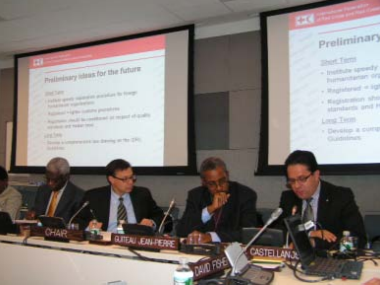
What are the lessons learned? And how to ensure that measures for legal preparedness are put in place?
That was the subject of discussion, when the preliminary findings of the International Federation of Red Cross and Red Crescent Societies’ (IFRC) study on the regulation of international relief to Haiti was presented to the diplomatic community at the UN Headquarters in New York on December 10. The seminar was co-hosted by the Permanent Mission of Australia to the UN and the Permanent Mission of Haiti to the UN.
Looking back, the earthquake in Haiti was in some ways unique, not only as to the massive death toll but also how it affected the capacities of the entire national government. However, in other ways, it was all too similar to major disaster operations around the world, in particular with regard to the difficulties raised in regulating outside relief in the absence of previously developed national rules. At the time of the earthquake, Haiti had a national emergency law as well as a national disaster management plan in place, but neither offered much guidance as to how to manage the enormous influx of international responders, among them hundreds of NGOs, which would have been a challenge for any government.
In the initial days following the earthquake, logistical challenges such as the dramatically reduced landing facilities at the Port-au Prince airport and the difficulties in bringing goods in overland from Santo Domingo limited incoming relief. These were also compounded by a 72-hour period when the airport was essentially closed to humanitarian traffic while the US military brought in its own troops and equipment. However, over the ensuring eight weeks, problems also began to arise due to the absence of control over incoming goods. Haitian customs authorities established an “emergency gate” at the airport and rapidly cleared humanitarian goods, but without any distinction between goods that were actually needed and those that were sent with the best of intentions but which served mainly only to take up space. This problem was reversed in March, when normal customs procedures were again imposed, creating long delays for the clearance of needed goods.
Moreover, there was an equally uncontrolled inflow or well intentioned individuals and organizations, many of whom with little experience and little understanding of how to operate or coordinate in disaster contexts. “Under Haitian law, NGOs are required to register before they may operate. However, among the several hundred NGOs who arrived in Haiti after the earthquake, fewer than ten have registered with the authorities to date,” noted Xavier Castellanos, Director, IFRC Americas Zone Office. “While many may be registered with the UN, they are not adequately connected with the authorities.”
“We do need better legal mechanisms to manage this challenge,” said Nadia Lochard, Head of Civil Protection for the Interior Ministry in the Western Department, Haiti. “In all, the structures and the capacity of the government to respond to natural disasters must be strengthened.”
Dr. Guiteau Jean-Pierre, Secretary-General, Haiti Red Cross Society, whose volunteers, staff members and premises were seriously affected, addressed the difficulties in responding to the emergency.
“Even if most of the Red Cross humanitarian aid got through, one of the lessons learned is clearly the need to preposition goods before a disaster strikes, “ he said. “Vehicles, for example, tended to take longer to enter the country, which affected the operation.”
Today, it takes approximately four months to legalize a vehicle (customs and number plates). This situation causes high rental costs for international actors present in the country; the cost of car rental within the country is about 4,000 USD per month, per vehicle. The result is that fewer resources are available for beneficiaries.
The lack of legal preparedness has had important consequences also in other disasters. One year after the Indian Ocean tsunami, 400 containers of relief items, including food, medications, body bags and other items that could no longer be used, were still in customs custody in Indonesia. In the large floods in Uganda 2007, customs officials allowed the Red Cross aid in quickly, but sent a massive bill later without warning to Uganda Red Cross. In 2005, after the earthquake in Pakistan, donations of unwanted clothes blocked the relief traffic and communities burned them for warmth.
“A great deal of work has been done in recent years to improve systems of coordination between international actors, in particular through the UN cluster system,” said David Fisher, Coordinator, IDRL Programme, and IFRC.
“However, not enough attention has been paid to how affected state governments can better prepare themselves to exercise their sovereign role to facilitate, regulate and oversee international assistance carried out on their territories.”
The IFRC has developed a set of “Guidelines for domestic facilitation and regulation of international disaster relief and initial recovery assistance”, known as the IDRL Guidelines. These guidelines were unanimously adopted by the state parties to the Geneva Conventions at the 30th International Conference of the Red Cross and Red Crescent in 2007.
Since their adoption, the IFRC and its members have been working with governments in over a dozen countries, such as Indonesia, Uganda and Pakistan, to undertake intensive reviews of their national laws in light of the IDRL Guidelines.
Also, several resolutions of the UN General Assembly have encouraged states to make use of the Guidelines. At the upcoming 31st International Conference of the Red Cross and Red Crescent, states are invited to report on their activities to carry out the IDRL resolution of 2007.
The Haiti IDRL study report is expected to be published in January 2011.